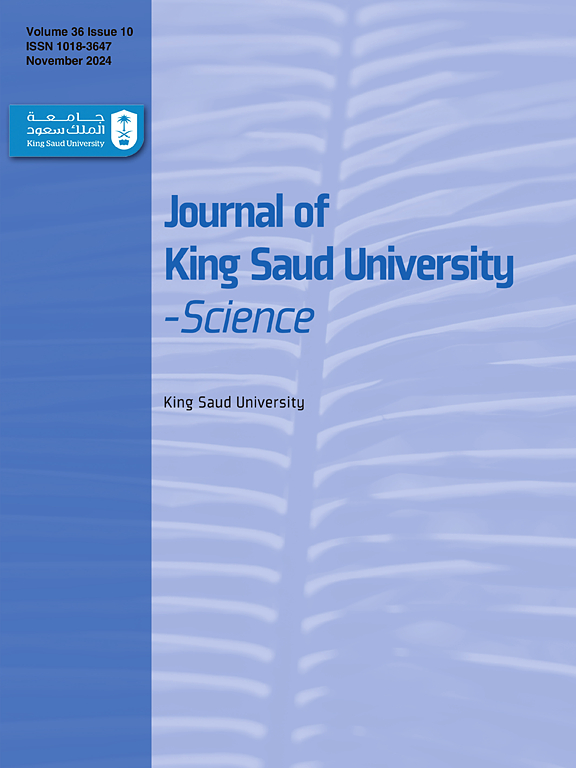Antioxidant activities of seeds and sprouts of Momordica charantia and their antibacterial efficacies against pathogenic bacteria isolated from hospitalized patients
IF 3.6
3区 综合性期刊
Q1 MULTIDISCIPLINARY SCIENCES
引用次数: 0
Abstract
During sprouting, significant chemical transformations frequently transpire, leading to variations in the concentrations of diverse bioactive compounds present in the seeds. Consequently, seeds and sprouts may have altered bioactivity. The current study aimed to evaluate the in vitro antioxidant activities of crude hydroalcoholic (70 % ethanol and 30 % distilled water) extracts of Momordica charantia seeds and sprouts and their antibacterial efficacies against morbific bacteria sourced from hospitalized patients. Utilizing three assays- DPPH (2,2-diphenyl-1-picrylhydrazyl), ABTS (2,2′-azino-bis (3-ethylbenzothiazoline-6-sulphonic acid), and ferric ions reducing power), the antioxidant activities were evaluated. The results revealed that the sprout extract significantly outperformed the seed extract in terms of Fe3+ ions reducing power, DPPH radical scavenging activity (IC50 = 163.37 ± 23.91 μg/ml), and ABTS radical scavenging activity (IC50 = 30.56 ± 6.90 µg/ml). The antibacterial efficacies against five morbific bacteria (Enterobacter cloacae, Escherichia coli, Enterococcus faecalis, Pseudomonas aeruginosa, and Klebsiella oxytoca) isolated from hospitalized patients were evaluated by the agar disc diffusion method. The findings indicated that the extracts derived from both sprouts and seeds exerted potent antibacterial efficacy by suppressing the growth of several clinical isolates. Both extracts possessed statistically significant (p < 0.05) antibacterial activity against Enterobacter cloacae and Escherichia coli. Seed extract had greater antibacterial activity than sprout extract against Enterococcus faecalis. Pseudomonas aeruginosa exhibited the lowest and identical susceptibility at three distinct concentrations (200 μg, 400 μg, and 800 μg) of seed extract. No extracts have shown any antibacterial action against Klebsiella oxytoca. The results of the study indicate that Momordica charantia sprouts exhibit a greater capacity to scavenge free radicals as antioxidants, whereas seeds possess more potent and broader antibacterial efficacy compared to sprouts.

苦瓜种子和芽的抗氧化活性及其对住院患者病原菌的抑菌作用
在发芽过程中,重要的化学转化经常发生,导致种子中存在的各种生物活性化合物浓度的变化。因此,种子和芽可能已经改变了生物活性。本研究旨在评价苦瓜种子和芽的粗水醇(70%乙醇和30%蒸馏水)提取物的体外抗氧化活性及其对住院病人病原菌的抗菌作用。采用DPPH(2,2-二苯基-1-吡啶肼基)、ABTS(2,2 ' -氮基-双(3-乙基苯并噻唑-6-磺酸)和铁离子还原力)3种测定方法对其抗氧化活性进行了评价。结果表明,豆芽提取物对Fe3+离子还原能力、DPPH自由基清除能力(IC50 = 163.37±23.91 μg/ml)和ABTS自由基清除能力(IC50 = 30.56±6.90µg/ml)均显著优于种子提取物。采用琼脂盘扩散法对住院患者分离的5种致病菌(阴沟肠杆菌、大肠杆菌、粪肠球菌、铜绿假单胞菌和氧化克雷伯菌)进行抑菌效果评价。结果表明,从芽和种子中提取的提取物可以抑制几种临床分离株的生长,具有较强的抗菌作用。两种提取物均具有统计学意义(p <;0.05)对阴沟肠杆菌和大肠杆菌的抑菌活性。种子提取物对粪肠球菌的抑菌活性高于芽提取物。铜绿假单胞菌在不同浓度(200 μg、400 μg和800 μg)的种子提取物中表现出最低且相同的敏感性。没有提取物显示出任何抗菌作用对克雷伯氏菌。研究结果表明,苦瓜芽作为抗氧化剂具有更强的清除自由基的能力,而种子具有比豆芽更强、更广泛的抗菌功效。
本文章由计算机程序翻译,如有差异,请以英文原文为准。
求助全文
约1分钟内获得全文
求助全文
来源期刊

Journal of King Saud University - Science
Multidisciplinary-Multidisciplinary
CiteScore
7.20
自引率
2.60%
发文量
642
审稿时长
49 days
期刊介绍:
Journal of King Saud University – Science is an official refereed publication of King Saud University and the publishing services is provided by Elsevier. It publishes peer-reviewed research articles in the fields of physics, astronomy, mathematics, statistics, chemistry, biochemistry, earth sciences, life and environmental sciences on the basis of scientific originality and interdisciplinary interest. It is devoted primarily to research papers but short communications, reviews and book reviews are also included. The editorial board and associated editors, composed of prominent scientists from around the world, are representative of the disciplines covered by the journal.
 求助内容:
求助内容: 应助结果提醒方式:
应助结果提醒方式:


